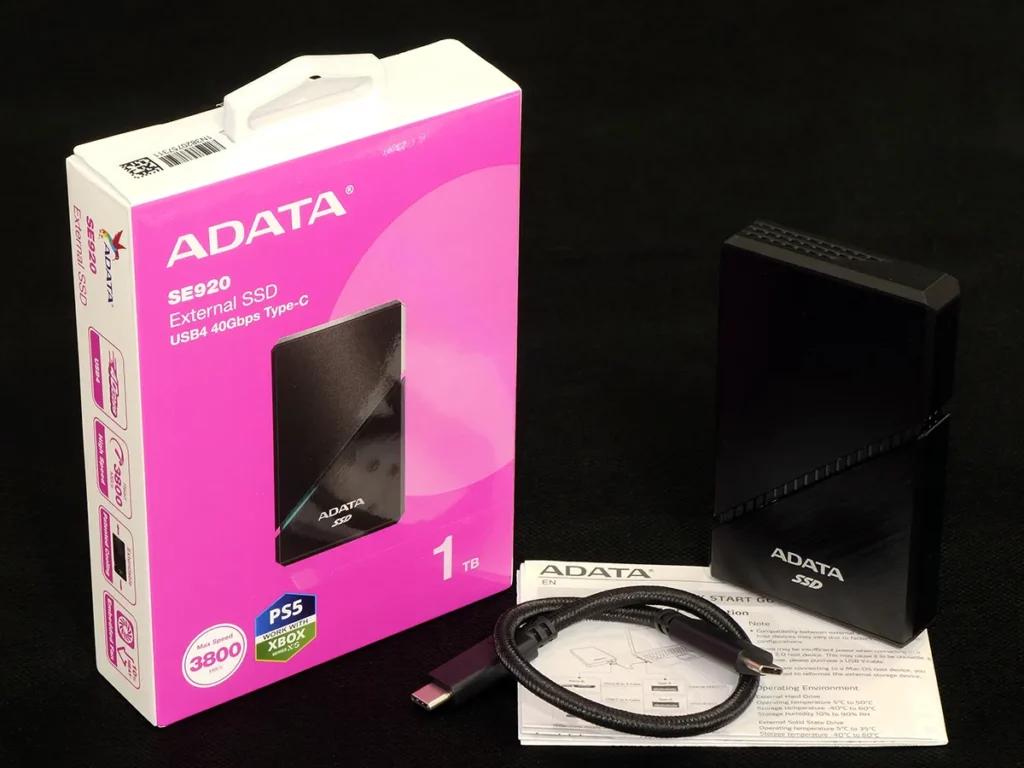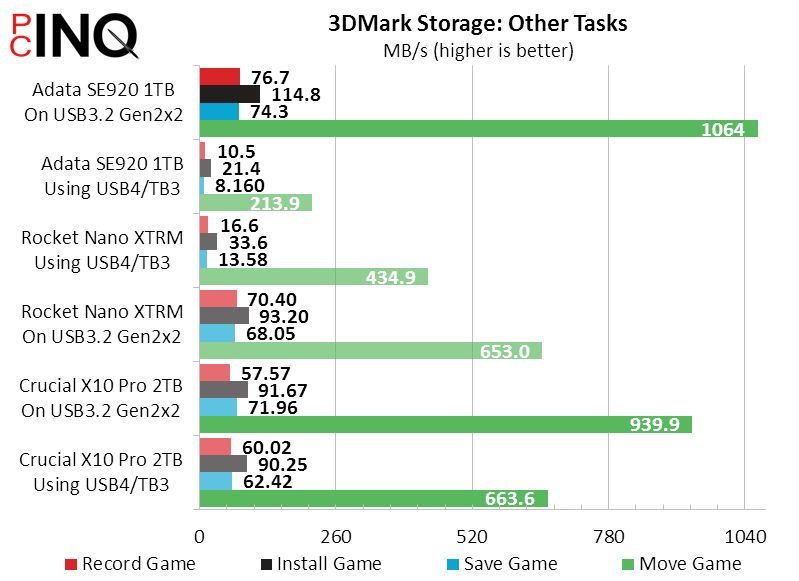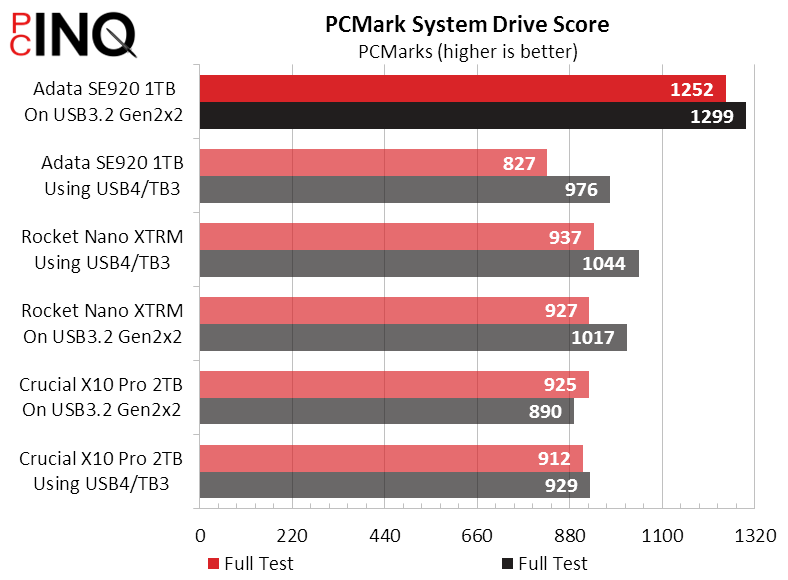Adata SE920 1TB USB4 External SSD Review
The first thing we noticed was the weight, and next that it rattled: These are the features that earned the USB4-enhanced SE920 its CES Innovation Award 2023, Taiwan Excellence Award 2022, and Red Dot Design Award 2022. Claiming read bandwidth up to 3,800MB/s read and 3,700MB/s writes, Adata’s latest external SSD is finally in our hands.
| Adata SE920 1TB (SE920-1TCBK) | |
| Type | USB Flash Drive |
| Form Factor | Pocket Portable |
| Dimensions | 105x63x16mm |
| Weight | 197g (w/cable) |
| Interface | USB4 (40Gb/s) |
| Warranty | 5-year limited |
| Price | $150 |
The extra heft comes from an extruded aluminum shell that protects the internal components from…being run over by a car? And the rattling comes from a pop-up cover that was designed loose enough to operate following such abuse.

Adata chose to use an extendable (from 105mm to 118mm in length) cover to switch the fan. Factory formatted in NTFS, the drive it houses is part of the p/n SE920-1TCBK external 1TB drive kit that also includes a cloth-covered USB Type-C cable and user guide. Adata says that the drive should be reformatted to exFAT by anyone who plans to use it on a Mac.

We’re going to guess that claimed peak performance is highly dependent upon your controller configuration, as we’ve never seen anything like 29Gb/s writes (converting 3700 megabytes to gigabits) from the Intel JHL8540 Thunderbolt 4 controller upon which every one of our USB4-enabled motherboards relies, but we’ll see if Adata’s drive can turn our fortunes!
| Test Hardware | |
| CPU | AMD Ryzen 9 7950X: 16C/32T 4.5-5.7 GHz, 64MB L3 Cache, Socket AM5 |
| CPU Cooler | Alphacool Core 1 Aurora, VPP655 with Eisbecher D5 150mm, NexXxoS UT60 X-Flow |
| Motherboard | ASRock X670E Taichi, Socket AM5, BIOS 1.28 (07-27-2023) |
| Graphics | Powercolor Red Devil Radeon 6750 XT: 2324-2623MHz GPU, 12GB GDDR6 |
| Power | be quiet! Dark Power Pro 10 850W: ATX12V v2.3, EPS12V, 80 PLUS Platinum |
| Memory | Lexar Thor OC DDR5-6000 2x16GB (32GB) CL32-38-38-96 1.30V |
| System Drive | Crucial T700 w/hs Gen5 PCIe 2.0TB SSD |
Thermal Test
Because we test pocket drives as portable devices rather than fixtures, all external drives are optimized for quick removal in all tests. We considered performance testing the SE920 in both its open (fan on) and closed (fan off) positions, but a thermal test revealed that this wouldn’t be necessary: The closed temperature under maximum stress only rose 4° and 7° from the open USB 3.2 and USB4 results shown below, respectively. That’s not enough to force throttling.

We’d probably run the drive open in regular use anyway, since a lower operation temperature tends to impart greater longevity for internal components. This despite Adata never saying that extending the drive would be necessary to qualify the drive’s five-year warranty.
Benchmark Results
Since USB4 and Thunderbolt 4 are developed from and are supposed to have the same bandwidth as Thunderbolt 3 (40Gb/s), the SE920 should perform on par with the Nano XTRM when using our system’s Thunderbolt 4 / USB4 controller. It instead matches the USB 3.2 Gen2x2 X10 Pro and performs slightly better when connected to the chipset’s native USB 3.2 Gen2x2 interface, even though that interface is limited to 20Gb/s.


In fact, the Nano XTRM’s habit of dropping back to USB 3.2 Gen2 (by 1) bandwidth makes the SE920 appear the more flexible solution, providing bandwidth in excess of that 10Gb/s limit when using either USB 3.2 Gen2x2 or USB4. And that pattern is repeated in AIDA64.


Differences in 3DMark’s storage test were so stark that we saved separate screenshots for the USB 3.2 and USB4 results: The SE920 wins as a USB 3.2 Gen2x2 drive, and does so primarily due to faster writes. And while it leads in “loading games” (a read-only test) as a USB4 drive, write functions such as record, install, save and move obliterate its overall performance score on that interface. We’re almost certain that Intel’s Thunderbolt 4 controller is responsible for the loss.



PCMark favors the SE920 on the chipset’s native interface, and losses when relying on the board’s Thunderbolt 4 controller are far less consistent or pronounced compared to other benchmarks.



ATTO shows a spike in IOPs for the SE920 on USB4, but otherwise it appears to perform best on the USB 3.2 Gen2x2 interface. A similar pattern emerges in CrystalDiskMark.




DiskBench is a writeback test, and the SE920 tears through it when using the USB 3.2 Gen2x2 interface.

In fact, the SE920 makes a better USB 3.2 Gen2x2 drive than Crucial’s X10, when rated using the real-world transfer patterns synthesized in 3DMark Storage and PCMark System Drive, along with the writeback test of DiskBench.

We had already ruled out this specific motherboard as a cause for poor Thunderbolt 3/4 performance in our Rocket Nano XTRM review by comparing other brands (Asus) and chipsets (Z790, Z690), and had even tried various cables, finding Intel’s JHL8540 Thunderbolt 4 controller as the only commonality. It’s the only USB4-compliant controller we’ve ever seen on an x86 motherboard, and Intel even says its driver version (1.41.1325.0) is current. But there is one thing we can do to boost the drive’s performance, and it should help under every controller: Enable write caching, manually, by disabling “Quick Removal” mode:

The fact that the SE920 is portable doesn’t mean that it has to be treated that way: Devices that are going to live most of their lives in a single location need not be “optimized for quick removal”, and Adata suggests that the SE920 could be a great fixture for expanding game console storage externally.


















The most sensible of the SE920’s previous non-caching test result came from connecting it to our system’s USB 3.2 Gen2x2 controller, so we used that as the performance baseline in viewing what could be gained by enabling cache. The SE920’s USB4 performance went from dud to champ, according to our games and applications test profiles.

With a per-terabyte price that’s over 50% greater than the compared Crucial X10 Pro, the $150 SE920 really only achieves a level of performance superiority to match its price premium after enabling write caching…by disabling the “quick removal” mode that’s kept so many of us out of trouble when unplugging drives for the past few years. We’ll be hanging onto the SE920 if for no other reason than to watch for Intel’s progress on this front.
| Adata SE920 1TB (SE920-1TCBK) | |
| Pros | Cons |
| Best overall USB 3.2 Gen2x2 performance Improved USB4 / Thunderbolt 4 Reads Five-year Warranty | Motherboard controller insufficiency? |
| The Verdict | |
| Though none of our JHL8540-enabled ports have shown sufficient write performance in default mode, storage geeks can find that missing performance by disabling quick removal mode and enabling write cache. Only then does the SE920 shine. | |

